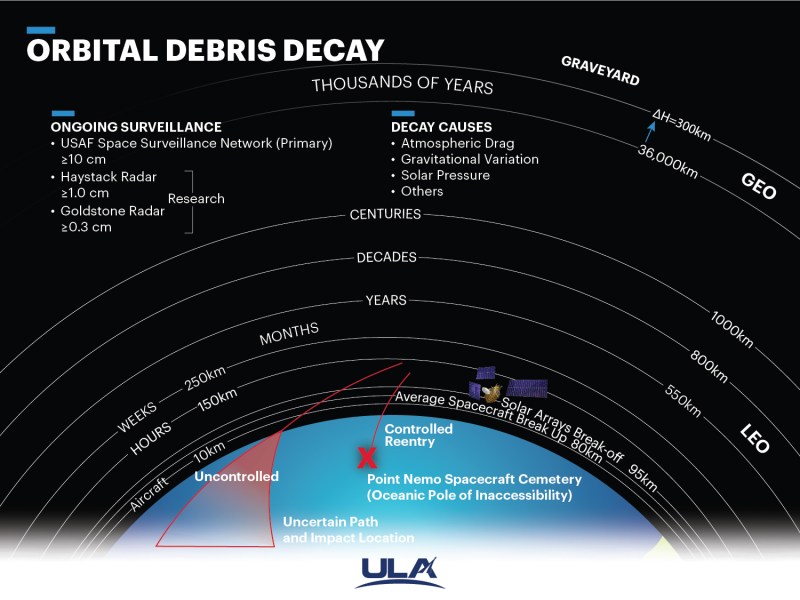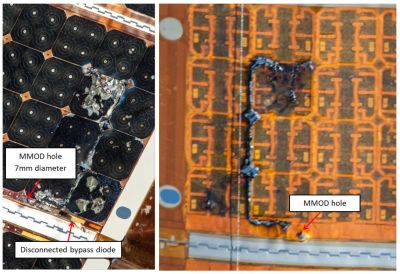
Hanging around in earth orbit is like walking into the middle of a Wild West gunfight — bullets are flying around everywhere, and even though none are purposefully aimed at you, one might have your name on it. Many of these bullets are artificial satellites that are actively controlled and monitored, but we also find dead satellites, remnants of satellites, discarded rocket stages, tools lost during spacewalks, and even flecks of paint and rust, much of it zipping around at multiple kilometers per second without any guidance.
While removing this space debris directly would be ideal, the reality is that any spacecraft and any spacesuit that has to spend time in orbit needs to be capable of sustaining at least some hits by space debris impacting it.
Orbital Mechanics
That it’s easy to create new debris should come as no surprise to anyone. What may take a bit more imagination is just how long it can take for this debris to make its way towards earth’s atmosphere, where it will uneventfully burn up. Everything in orbit is falling toward the earth, but its tangential velocity keeps it from hitting — like a marble spinning around the hole in a funnel. Drag from the planet’s atmosphere is the friction that eventually slows the object down, and where it orbits in the planet’s atmosphere determines how long this descent will take.

As cited by NASA’s Orbital Debris Program Office at ARES in their FAQ, there are over 23,000 debris objects larger than 10 cm in orbit, in addition to more than half a million objects between 1 cm and 10 cm, and millions of objects between 1 mm and 10 mm. The principal sources of orbital debris are satellite explosions and collisions. This includes China’s 2007 anti-satellite (ASAT) test, as well as India’s 2019 and Russia’s 2021 ASAT tests, which happened in addition to the USSR & US 57 (total) ASAT tests.
Satellites sometimes explode, such as the 2004 and 2015 US DSMP satellite explosions. Other times satellites collide with each other, like Iridium-33 with Cosmos-2251, get hit by debris or micrometeorites, and so on. As in low earth orbit (LEO) debris tends to travel at speeds upwards of 7 km/s.
Depending on the mass of the debris object, the effect of it impacting with a satellite or other object in its path, likely adding another ~7 km/s into the opposite direction, could be the transfer of gigajoules worth of kinetic energy, equivalent to tons of TNT. Even a fleck of paint traveling at these speeds have been shown to cause significant damage, especially to fragile structures such as solar panels. As mentioned, this makes it essential that such structures can accept some level of impact damage.
Always the Small Ones

Although obviously carrying more energy, the nice thing about the larger debris pieces is that they are relatively easy to track using ground-based equipment. A satellite or space station can use onboard thrusters if it gets too close to the orbit of one of those big pieces of debris.
This then mostly leaves the smaller debris, especially the small flakes and grains that are too small to track, but with enough mass to cause significant damage. For decades, the go-to protection for spacecraft is the Whipple shield. Much like the similar multi-shock shield, it is a type of spaced armor, which is a type of armor first made popular with iron warships of the mid-19th century.
Instead of simply making armor thicker, multiple layers are used, with empty space or some kind of padding in between them. This saves on weight, while allowing for an incoming projectile to harmlessly dissipate its energy. This same principle can be seen with e.g. the windows on the ISS, which consists out of multiple layers. In the case of the ISS’ Cupola, there are four layers:
- Outer debris pane.
- Two 25 mm pressure panes.
- Inner scratch pane.
The outer pane is supposed to dissipate most of the energy of a strike, with the layer behind it catching the debris cloud, which should be traveling at slow enough speeds that they should do no significant harm. Each window can be replaced in-orbit after fitting an external cover, should they suffer so much damage that replacement is warranted.

For the remaining sections of the ISS, ballistic panels are placed some distance from the primary hull, which are designed to capture and dissipate the energy from micrometeorites and small orbital debris. Meteoroid and orbital debris damage on the ISS has been studied for decades now, with a 2019 paper by Hyde et al. describing recent findings.
An interesting finding is that of damage to the ISS’ Solar Array Wings. In one case an micrometeorite impacted one of the panels and created a 7 mm diameter hole. This destroyed a bypass diode in the panel and caused a current buildup that ultimately resulted in a nearly 40 cm long burn-through along the edges of three cells.
Obviously, protecting solar panels in this environment is anything but easy, as by definition adding protective panels in front of them rather defeats the entire purpose of having solar panels. The ISS has over 250,000 cells, with the expectation that some of them will inevitably be lost over time. In June 2021, astronauts at the ISS installed new solar panels to replace the oldest.
While replacing solar panels like this is a viable option to deal with accumulated damage on a space station, it is less practical for satellites, which should thus have sufficient excess electrical capacity to deal with the loss over time.
Offense as Best Defense
Because the debris in some orbits will hang around for decades or longer, we may eventually reach a point where active removal of this debris becomes a necessity. This is where orbital mechanics and the incredible amount of space in, well, space make things very tricky. Even though the risk of orbital debris is high, because satellites and debris are both moving around quite quickly, the density is very low. That’s why astronauts on the ISS don’t see bits of debris zipping by all the time.
This sparseness makes active debris removal a chore, and explains why recent high-profile missions such as RemoveDEBRIS, ClearSpace-1, and others focus on large debris that travels in previously known orbits. They often require satellites to move within a certain distance from the target, and perform delicate operations. As previously established, the largest threat comes from the debris that cannot be easily tracked, which would thus seem to largely defeat these clean-up methods.
Here perhaps the best method is to not actively hunt these objects down, but to passively catch them using an expansive system, much like how a spider uses a web to catch unsuspecting prey. This is what Russian startup StartRocket with their Foam Debris Catcher has in mind. The use of foam to capture orbital debris is not new, with an ESA report from 2011 also covering the use of foam in depth.
No Littering
Even with mitigation solutions in place, and with orbital debris removal methods being investigated and possibly being deployed over the coming decades, the best thing we can do right now is to prevent making more of a mess. These days, space traffic management is handled primarily by the United Nations Office for Outer Space Affairs (UNOOSA), with national policies following international agreements on preventing orbital debris and other considerations.
The increasing focus on re-usability of spacecraft is a fortunate development. The grandest goal of the US Space Shuttle program — that it would serve as a platform for servicing satellites — never came to fruition beyond servicing Hubble. However, we may hope to soon see an end to the routine discarding of simply leaving entire rocket stages floating around, reducing at least one source of space pollution.
0 Commentaires